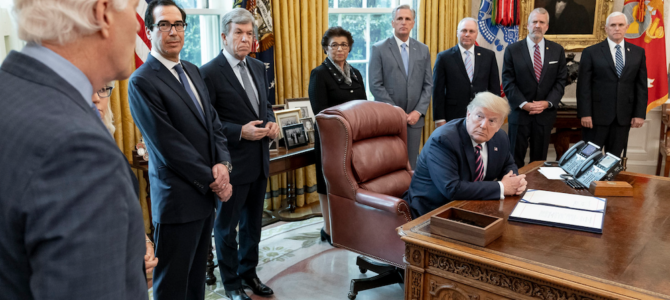
America’s official unemployment rate is a shocking 11 percent, meaning about 18 million Americans are out of work. That’s bad enough, but in addition 30 million Americans are receiving weekly jobless benefits, meaning the true unemployment number could be much higher, between 15 and 20 percent. The Bureau of Labor Statistics doesn’t count people as unemployed if they haven’t looked for a job in a certain amount of time, but changes to benefits rules have allowed many jobless to receive benefits without looking for work.
In other words, America’s employment situation is a volatile disaster that is hard to measure. Millions of jobless Americans face permanent unemployment and long-term separation from the labor market. This will do lasting damage to the economy, these workers, and the millions of young people who planned to enter the workforce in 2020-21.
Much focus has been on the damage caused by state and local policymakers, who opted for draconian lockdowns and refused to reopen, despite data that was far better than expected. Policymakers in this category, such as Michigan Gov. Gretchen Whitmer, deserve plenty of ridicule. They hurt Americans in their efforts to score political points.
Attention has also been paid to the $2.2 trillion CARES Act, the stimulus bill passed as the economy was shut down in March. It aided businesses with retaining employees, and the Federal Reserve bought the risky credits of companies that, pre-virus, were up to their ears in debt because CEOs decided to lever-up in order to buy back stock (which boosted pay packages).
But too little attention has been paid to how the CARES Act, and a subsequent tweak, will affect the labor market’s recovery. Congress has created a policy cocktail, authored by both Republicans and Democrats, that may keep our unemployment rate elevated throughout 2020. One incentive may even cause mass layoffs a month before the presidential election.
Enhanced Unemployment Benefits
Under the multitrillion-dollar Coronavirus Aid, Relief, and Economic Security (CARES) Act, Congress increased unemployment benefits with $600 extra per week. These benefits are so generous, many employers report problems hiring workers back. In fact, about half of those who are unemployed are receiving more money via the enhanced benefit than they did while working. For workers who made roughly $60,000 or less, the enhanced benefits are more lucrative than work. Obviously, this has elevated the unemployment rate.
The enhanced unemployment benefit of $600 per week expires at the end of July, however. Already, congressional Democrats want to redo the full $600 per week, claiming that any substantial cut to the benefit would harm needy Americans.
Notably, a huge predictor of the success of an incumbent president’s re-election bid is the change in the unemployment rate in the months leading up to the election. If President Donald Trump is fortunate enough to have the unemployment rate fall sharply between now and October, he will likely win re-election. If the unemployment rate stays the same or rises, he will likely lose the election. Democrats’ plan to reauthorize the enhanced unemployment benefits of $600 extra per week, no matter their altruism, will just happen to keep the unemployment rate high heading into the election.
Democrats aren’t the only ones who want the benefit continued, though. Wall Street is also clamoring for some kind of continuation of the expanded benefit, fearing that its complete end will hurt consumer spending and thus stock valuations. Even many Republicans want to ratchet the benefit down rather than cut it off entirely. Right now, Republicans are trying to craft an added incentive to get Americans back to work, but state unemployment programs are limiting their options.
Small Businesses and Rehiring
Congress has spent well more than half a trillion dollars on the Paycheck Protection Program (PPP) in aid to small businesses in the form of loans. The loans are meant to be almost entirely forgiven and are incredibly low-cost even if they are not forgiven.
But the ability to be eligible for loan forgiveness — essentially making the PPP “free money” — came with strings attached. Under the original CARES Act, to qualify for loan forgiveness, small businesses had until June 30 to substantially rehire their employees.
Yet Congress passed a law several weeks ago to change that deadline to Dec. 31, and allow PPP loans to be used toward payroll until that date. Congress also allowed a greater share of the PPP loans, on the margin, to be used to cover overhead.
Finally, Congress allowed loan forgiveness to occur, even if the payroll is not returned to normal, if the business can’t find qualified employees, if employees refuse to return, or if the business is unable to restore operations to Feb. 15 levels due to the Wuhan virus.
Let’s unpack this a bit. Before these changes occurred, the biggest risk was that employment would be artificially elevated until June 30, at which point small businesses would lay off employees. Now the risk is that this policy change prolongs the employment recovery.
This is because the sum of the changes reduces the incentive for firms to hire employees back quickly this summer. Instead, firms need to hire employees back by year end to be eligible for loan forgiveness, or they can show that operations (revenues) are still below Feb. 15 levels and still receive loan forgiveness. Note that the election occurs Nov. 3.
Of all the incentives Congress has created, this is the most understandable. The PPP was geared toward maintaining payrolls and has been shifted incrementally toward ensuring small businesses remain solvent. Yet the change may dampen the employment recovery, and it reshapes the initially stated intent of the program.
White-Collar Layoffs a Month Before the Election
Americans got stimulus checks and enhanced unemployment benefits. Small businesses (and some not-so-small businesses) got PPP loans, which will probably turn into grants. Corporate America got a host of Federal Reserve programs, largely from a money pile allocated through the Treasury Department’s Exchange Stabilization Fund.
This money also comes with strings attached. Many Exchange Stability Fund recipients, such as “mid-sized businesses,” can’t make substantial layoffs until Sept. 30. This deadline is hard and fast and, due to political pressures, will not be changed. This could mean that Oct. 1 and the weeks thereafter see massive white-collar layoffs. Or it could mean that as service-sector jobs are added and the economy continues to reopen, those gains will be offset by white-collar job losses going into the fall and winter.
Airlines are already planning massive layoffs for Oct. 1. The carnage will certainly not be limited to airlines, given how much of corporate America has taken at least some of this funding. Corporate America already had a very high debt level, relative to history, before the coronavirus pandemic and shutdowns hit the economy.
Who Designed These Programs?
Walk through the incentives. Instead of seeing massive layoffs all at once, and a year of a strong jobs rebound, layoffs have potentially been backlogged until one month before the presidential election. One wonders: Who designed this program and set the date to allow layoffs — after a company has received massive bailout funds — at Oct. 1? Which Republicans were involved in crafting this program, and why did they not consider the political incentives?
Political incentives aside, the American people are hurting. The unemployed are being compensated under a benefit package better than the employed are for their labor. Hundreds of billions were given freely to smaller businesses so they could keep supporting their employees. Yet new rules have almost removed the alleged reason behind the program in the first place, and have pushed employees’ rehire date, if they get their jobs back at all, until after the election. Why spend all this money and make Americans wait until the end of the year to get their jobs back?
Washington is presently putting together another stimulus package. Policymakers must ensure they don’t once again create bad incentives that keep the unemployment rate elevated. That starts with not re-upping the $600-per-week enhanced unemployment benefit. Passing nothing at all would be better than passing something that will hurt the American people in the long run.








